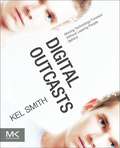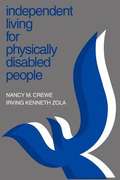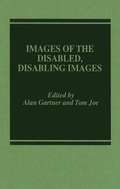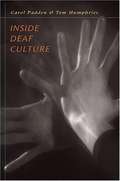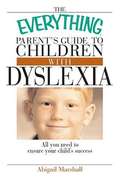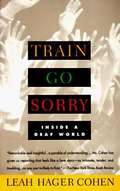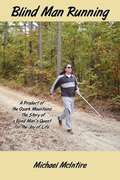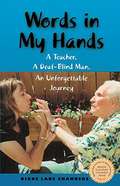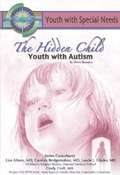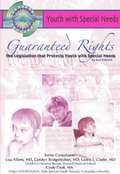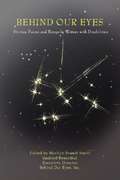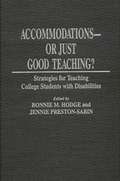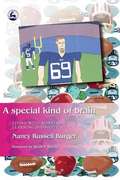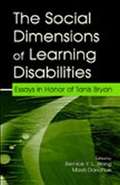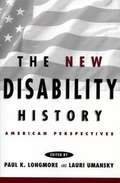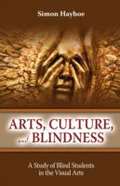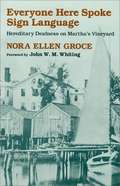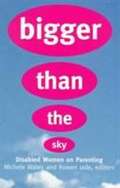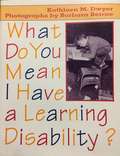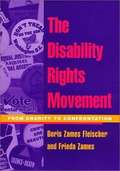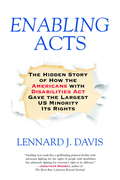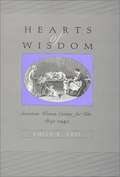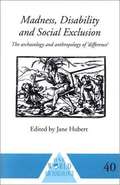Special Collections
Disability Collection
Description: Bookshare is pleased to offer a collection focused on the topic of disability and accessibility. #disability
- Table View
- List View
For Hearing People Only
by Matthew S. Moore and Linda LevitanA question and answer book to those questions that the general public wants to know about Deafness, the Deaf culture, and what it is like to be Deaf in America.
Digital Outcasts
by Kel SmithThe blind person who tries to make an online purchase. The young girl who cannot speak due to a cognitive disability. The man confined to his home due to permanent injury. The single mother with a long-term illness who struggles to feed her family. With one in seven people worldwide currently living with a disability, the term "outcast" covers numerous scenarios. Digital outcasts rely on technology for everyday services that many people take for granted. However, poorly designed products risk alienating this important (and growing) population. Through a "grass roots" approach to innovation, digital outcasts are gradually taking action to transform their lives and communities. This emerging trend provides exciting learning opportunities for all of us. Citing real-world case studies from healthcare to social science, this book examines the emerging legal and cultural impact of inclusive design. Gain a better understanding of how people with disabilities use technology Discover pitfalls and approaches to help you stay current in your UX practices Anticipate a future in which ambient benefit can be achieved for people of all abilities and backgrounds.
Independent Living for Physically Disabled People
by Irving Kenneth Zola and Nancy M. CreweA text book for students in Rehabilitation Counseling classes.
Images of the Disabled, Disabling Images
by Alan Gartner and Tom JoeIn this collection of a dozen essays, writers with strong backgrounds in the disability rights movement examine the roots of public attitudes toward the disabled. Several essays consider portrayals of people with disabilities in literature, film, and journalism. Others explore social policy toward the disabled in education, employment, and health-care. Nat Hentoff's powerful piece, ""The Awful Privacy of Baby Doe," expresses the author's outrage over the case of a child born with spina bifida who was denied treatment because doctors persuaded her parents that she would be better off dead.
Inside Deaf Culture
by Tom Humphries and Carol PaddenIn this [account] of the changing life of a community, the authors of Deaf in America reveal historical events and forces that have shaped the ways that Deaf people define themselves today. Inside Deaf Culture relates Deaf people's search for a voice of their own, and their proud self-discovery and self description as a flourishing culture.
Padden and Humphries show how the nineteenth-century schools for the deaf, with their denigration of sign language and their insistence on oralist teaching, shaped the lives of Deaf people for generations to come. They describe how Deaf culture and art thrived in mid-twentieth-century Deaf clubs and Deaf theater, and they profile controversial contemporary technologies.
Most triumphant is the story of the survival of the rich and complex American Sign Language long misunderstood but finally recognized by a hearing world that could not conceive of language in a form other than speech. In a moving conclusion, the authors describe their own very different pathways into the Deaf culture, and reveal the confidence and the anxiety of the people of this tenuous community as it faces the future.
The Everything Parent's Guide To Children With Dyslexia
by Abigail MarshallDyslexia affects 10 to 15 percent of the U.S. population. If you're the parent of a child with dyslexia you should read this book. The Everything(r) Parent's Guide to Children with Dyslexia, by Abigail Marshall gives you a complete understanding of what dyslexia.
Train Go Sorry
by Leah Hager CohenThis portrait of New York's Lexington School for the Deaf is not just a work of journalism. It is also a memoir, since Leah Hager Cohen grew up on the school's campus and her father is its superintendent. As a hearing person raised among the deaf, Cohen appreciates both the intimate textures of that silent world and the gulf that separates it from our own.
Blind Man Running
by Michael McintireAutobiography of a blind man's journey through life as a traveling musician
Hands-On Parenting
by Debbie BaconChapters include topics such as: newborns and the basics, communicating with your child, organizing and children's clothing, toilet training, traveling with your children, social issues for blind parents, and toys and game suggestions for families.
Words in My Hands
by Diane ChambersBert Riedel, an 86-year-old deaf-blind pianist, cut off from the world since age 45, discovers a new life through hand-over-hand sign, taught to him by the author.
The Hidden Child
by Sherry BonniceAutism presents unique challenges to the families and friends of young people with this condition. Some children with autism seem to be individuals of great contradiction--unable to perform well in one educational area, while having near-genius abilities in other areas. Children with autism may act withdrawn, unresponsive, or unemotional. They may at times seem impossible to understand. Challenges like these lead to many misunderstandings about autism and the abilities of children with this condition. In The Hidden Child: Youth with Autism, you will read the story of Livie and her brother Tucker, who has autism. As Livie and her parents experience the challenges that raising Tucker brings, the reader experiences the turmoil and strength needed to face the emotional roller coaster that autism can cause. As you read, you will not only learn about Livie's and Tucker's experiences. You will also learn facts about autism, what the symptoms of autism are, and where to turn for further information or help with issues related to autism. This book will also teach you about the different educational treatments that are available to help each unique child. Through early intervention, education, and further research, individuals with autism can lead more fulfilling lives.
Guaranteed Rights
by Joan EsherickFrom the Book jacket: A local modeling program denies thirteen-year-old Maria the chance to participate in its workshops. The reason? She uses a wheelchair. What should she do? The state of Alabama nearly pulls the plug on a disabled college student's medical support. Why? He was approaching his twenty-first birthday. Are there other avenues this teen can pursue? Employers reject nineteen-year-old Manuel's job application because he has a history of seizures, even though his seizures are completely controlled by medication and his last episode was more than five years ago. Can Manuel appeal? These cases reflect real teens in real circumstances. And all three represent how special needs legislation impacts youth with special needs. Youth with special needs want the chance to reach their potentials, despite the challenges they must overcome. Some face physical or medical challenges. Others have psychological or emotional disorders. Still others live in at-risk circumstances beyond their control. Some may even be in jail. American law affords all these young people certain rights and protections, regardless of their special needs. What are these rights? Where do they come from? Whom do they protect? Guaranteed Rights: The Legislation That Protects Youth with Special Needs will answer these and other questions. It examines the history, passage, and enforcement of special needs law as it relates to appropriate education, appropriate medical care, and equal access to jobs, public places, and services for all youth with special needs.
Behind Our Eyes
by Marilyn Brandt SmithLaugh with the blind guy who gets in the wrong car and almost gets arrested. Cry with the little girl whose parents resent her blindness so much that they constantly break her spirit. Rejoice over battles won against burglars, abusive spouses, self-doubt, and health care personnel who keep forgetting their patient can't see. Reflect on the issues of employment, acceptance, independent travel, and the appreciation of nature and other hobbies. This anthology attempts to bridge the gap between how disabled people are viewed by society and how they really live. Read about the writers' workshop, and join the group if you enjoy writing.
Accommodations--or Just Good Teaching?
by Bonnie M. Hodge and Jennie Preston-SabinThis is an excellent book for college professors, college students with disabilities, or people working with disabled college students. it explains the different accommendations available for these students, and what exactly the law covers. Definitely worth reading if you are a student planning to go to college and who have a disability.
A Special Kind Of Brain
by Nancy Russell BurgerSharing the experience of bringing up a child with nonverbal learning disability (NLD), this warm and accessible book offers advice on subjects ranging across diagnosis and therapy, children's interaction with each other, suitable activities for a child with NLD and how to discuss NLD with children. An essential guide, this book will reassure, advise and inform parents and professionals who work with children with NLD.
The Social Dimensions of Learning Disabilities
by Mavis Donahue and Bernice Y. L. WongEssays discussiing the social aspects of Learning Disabilities
The New Disability History
by Paul K. Longmore and Lauri UmanskyIn a series of scholarly but highly readable essays, this book opens discussion on the role of disabled people in American history. It also examines how history has been affected by perceptions of disability. For example, one article looks at the ways disability has been used to strengthen prejudice against particular ethnic groups and to justify discrimination - "experts" have often claimed that one or another group of immigrants is genetically inferior and prone to mental retardation or physical frailty. One essay is based on the Civil War letters of a deaf man to his family. Another looks at the ways Helen Keller's Socialist beliefs were stifled by those around her.
Arts, Culture, and Blindness
by Simon HayhoeThis book explores one of the most powerful myths in modern society: the myth that blind people are incapable of understanding and creating visual arts.
Everyone Here Spoke Sign Language
by Nora E. GroceFrom the seventeenth century to the early years of the twentieth, the population of Martha's Vineyard manifested an extremely high rate of profound hereditary deafness.
In stark contrast to the experience of most deaf people in our own society, the Vineyarders who were born deaf were so thoroughly integrated into the daily life of the community that they were not seen-- and did not see themselves-- as handicapped or as a group apart. Deaf people were included in all aspects of life, such as town politics, jobs, church affairs, and social life.
How was this possible? On the Vineyard, hearing and deaf islanders alike grew up speaking sign language. This unique sociolinguistic adaptation meant that the usual barriers to communication between the hearing and the deaf, which so isolate many deaf people today, did not exist.
Bigger than the Sky
by Michele Wates and Rowen JadeIn this anthology the editors gather work by a variety of women with disabilities, united by the theme of parenting. Many contributors write enthusiastically about their parenting experiences; some explain their choice not to raise children; some write about meaningful relationships with children outside the traditional parent role. The authors represent disabilities including blindness, deafness, MS, post-polio, cerebral palsy, and cognitive and psychiatric disabilities.
What Do You Mean I Have a Learning Disability?
by Kathleen M. DwyerTen-year-old Jimmy just accepts the fact that other kids can do things better than he can. It's always been that way--but now Jimmy is starting to think there must be a reason. One day he whispers to his cat, "I'm so stupid. I know I am." This true story has a happy ending. One of Jimmy's teachers encouraged his parents to have Jimmy tested, and it turned out that he had a learning disability. Hard work and perseverance, and the support of his family, helped Jimmy overcome his disability. For children who are learning disabled, and for their families and friends, this inspiring book offers encouragement and support in a shared effort.
The Disability Rights Movement
by Doris Z. Fleischer and Freida ZamesBased on interviews with almost a hundred activists, this book provides a detailed history of the struggle for disability rights in the United States. It is a complex story of shifts in consciousness and shifts in policy, of changing focuses on particular disabilities such as blindness, deafness, polio, quadriplegia, psychiatric and developmental disabilities, chronic conditions (for example, cancer and heart disease), AIDS, and of activism and policymaking across disabilities.
Referring to the Americans with Disabilities Act as "every American's insurance policy," the authors recount the genesis of this civil rights approach to disability, from the almost forgotten disability activism of the 1930s, to the independent living movement of the 1970s, to the call for disability pride of the 1990s. Like other civil rights struggles, the disability rights movement took place in the streets and in the courts as activists fought for change in the schools, the workplace, and in the legal system. They continue to fight for effective access to the necessities of everyday life-to telephones, buses, planes, public buildings, restaurants, and toilets.
The history of disability rights mirrors the history of the country. Each World War sparked changes in disability policy and changes in medical technology as veterans without limbs and with other disabilities returned home. The empowerment of people with disabilities has become another chapter in the struggles over identity politics that began in the 1960s.
Today, with the expanding ability of people with disabilities to enter the workforce and a growing elderly population, issues like longterm care are becoming increasingly significant at a time when HMOs are trying to contain health care expenditures.
Enabling Acts
by Lennard J. DavisThe first significant book on the history and impact of the ADA--the "eyes on the prize" moment for disability rights.
The Americans with Disabilities Act (ADA) is the widest-ranging and most comprehensive piece of civil rights legislation ever passed in the United States, and it has become the model for disability-based laws around the world. Yet the surprising story behind how the bill came to be is little known.
In this riveting account, acclaimed disability scholar Lennard J. Davis delivers the first behind-the-scenes and on-the-ground narrative of how a band of leftist Berkeley hippies managed to make an alliance with upper-crust, conservative Republicans to bring about a truly bipartisan bill.
Based on extensive interviews with all the major players involved including legislators and activists, Davis recreates the dramatic tension of a story that is anything but a dry account of bills and speeches. Rather, it's filled with one indefatigable character after another, culminating in explosive moments when the hidden army of the disability community stages scenes like the iconic "Capitol Crawl" or an event some describe as "deaf Selma," when students stormed Gallaudet University demanding a "Deaf President Now!"
From inside the offices of newly formed disability groups to secret breakfast meetings surreptitiously held outside the White House grounds, here we meet countless unsung characters, including political heavyweights and disability advocates on the front lines. "You want to fight?" an angered Ted Kennedy would shout in an upstairs room at the Capitol while negotiating the final details of the ADA. Congressman Tony Coelho, whose parents once thought him to be possessed by the devil because of his epilepsy, later became the bill's primary sponsor. There's Justin Dart, adorned in disability power buttons and his signature cowboy hat, who took to the road canvassing fifty states, and people like Patrisha Wright, also known as "The General," Arlene Myerson or "the brains," "architect" Bob Funk, and visionary Mary Lou Breslin, who left the hippie highlands of the West to pursue equal rights in the marble halls of DC.
Published for the twenty-fifth anniversary of the ADA, Enabling Acts promises to ignite readers in a discussion of disability rights by documenting this "eyes on the prize" moment for tens of millions of American citizens.
Hearts of Wisdom
by Emily K. AbelDrawing upon a wealth of diaries, letters, and case records from hospitals and social service agencies, the author examines the shifting roles of caregivers between 1850 and 1940. In addition to the diaries and letters of literate white woman, she turns to slave narratives from the antebellum south and records from health-care agencies serving American Indians during the first part of the 20th century. Abel shows that women in the 19th century gained self-esteem and status through their knowledge of home remedies and nursing techniques. The medical profession gained strength with the discovery of microbes and the development of medications to treat specific diseases. During the 20th century professionals discredited women who provided health care at home. One chapter discusses mothers of children with epilepsy or mental retardation, who were pressured to place their children in institutions and to sever emotional ties with them. Another chapter explores the shift from American sign language to oralism in the education of deaf children, and the impact this had upon mothers. Abel concludes by looking briefly at the current trend to return more and more caregiving to the home.
Madness, Disability and Social Exclusion
by Jane HubertA unique work that brings together a broad range of specialist disciplines to create a new perspective on social and physical exclusion from society. Brings a much needed comparative approach to the subject of disability. Confinement, hermaphrodites, killing of disabled children, leprosy, deafness, and funerary rituals are explored.

